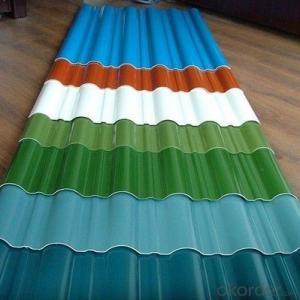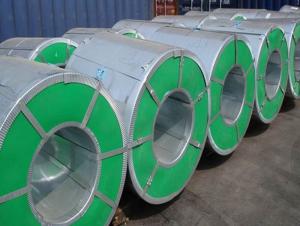Industrial and Civil Architecture Roof Boarding Color Coated Sheet
- Loading Port:
- Tianjin
- Payment Terms:
- TT or LC
- Min Order Qty:
- 25 m.t.
- Supply Capability:
- 50000 m.t./month
OKorder Service Pledge
OKorder Financial Service
You Might Also Like
1.Industrial and Civil Architecture Roof Boarding /color coated sheet Features:
. A strong anti-corrosion properties, good corrosion resistance. The use of hot dipped galvanized steel substrates for the Color Painted steel coil, with the exception of zinc have anti-corrosion layer, a layer of coatings have seized coverage and protection, allowing effective anti-rust products, galvanized coil about life than double.
. A good cold-formed molding processing, users can directly processed into finished products. Substituting wood to steel, easy to transport, and efficient construction, energy conservation.
2.Applications of Industrial and Civil Architecture Roof Boarding /color coated sheet
* Used as roof panel, wall panel in steel structure in warehouse, factories exhibition hall container houses, cold storage
*It is also mainly used in light industry, automobile, construction, animal husbandry, fishery and commerce, etc,

3.Product Introduction information:
PRODUCT | Industrial and Civil Architecture Roof Boading /color coated sheet |
STANDARD | GB/T-12754: 2006, JIS330, ASTM A653, JIS G330, GB/T2518, ASTM A792, JIS G3321, JIS G3317 |
BASE METAL | Hot dipped Galvanized steel sheet/coil, Hot dipped Galvalume steel sheet/coil |
EQUIPMENT | Double coating double baking; three coating three painting |
SUPPLY CAPACITY | 500,000 Tons per Year |
SIZE | Thickness: 0.3mm-1.0 mm,thickness tolerance: +/- 0.02mm Width : 700mm—1250mm |
ZINC COATING | 30g/m2-150g/m2 |
PAINT THICKNESS | Top Side: 10-25 microns; Back Side: 4-8 microns |
COIL WGT | Normally 5 Tons per Coil, aslo as required by customer |
COIL ID | 508mm/610mm |
SURFACE PAINT | EP, PE, HDP, SMP, PVDF |
4.Color Coated Galvalume Steel Coil image:
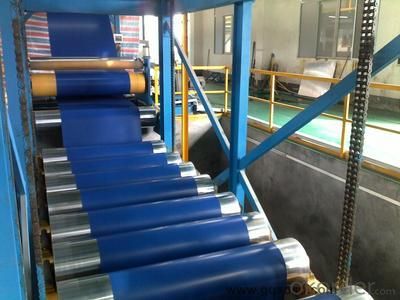
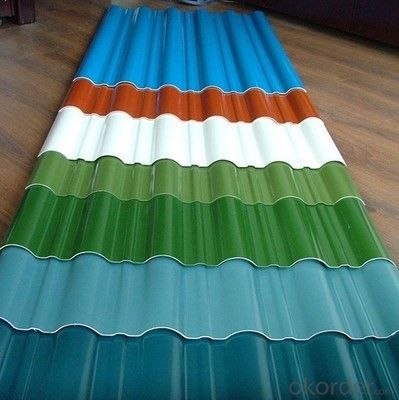
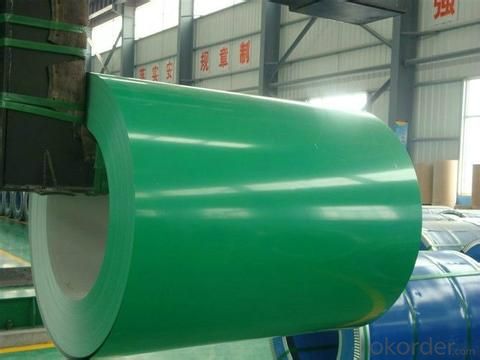
5.FAQ
We have organized several common questions for our clients,may help you sincerely:
①How about your Warranty?
Warranty: 1-Year for the whole light. Warranty is based on correct storage, installation, using and maintenanc
②How to guarantee the quality of the products?
We have established the international advanced quality management system,every link from raw material to final product we have strict quality test;We resolutely put an end to unqualified products flowing into the market. At the same time, we will provide necessary follow-up service assurance.
③How long can we receive the product after purchase?
In the purchase of product within three working days, We will arrange the factory delivery as soon as possible. The pecific time of receiving is related to the state and position of customers.Commonly 7 to 10 working days can be served.
- Q:Why cold rolled stainless steel sheet is lower than cold rolled stainless steel coil?
- Kaiping is the flat coil set into common size. A negative tolerance is the actual thickness of the plate, not the thickness of the mark.
- Q:Can steel coils be welded?
- Yes, steel coils can be welded. Welding is a common method used to join steel coils together or to other steel components, allowing for the formation of strong and durable connections in various applications.
- Q:I've been looking into battle-ready katanas a lot lately. And I've come across some debates between the best forges and steels to be used for them. The functional katanas I use now are Musashi brand katanas, using 1045 carbon steel. They each cost roughly $200-$250. The straight carbon steels are mentioned in the debates, but they aren't very sophisticated in their design. Now the higher end of this middle class of katana ($250-$1000) uses higher carbon. spring, damascus, and other various steels and combinations. I've heard a lot about the strength of damascus steel and it's cutting power. But I look for more than that. I've also been looking at (and for) durability, flexibility, and how well it stands up to contact. So I guess what I'm asking is for the opinion of people who have used these steels, and an answer on what the community thinks is the best steel for a mid range ($250-$1000) battle-ready katana. Looking forward to some good answers.
- There is no such thing as a battle ready katana... if it is not ready for battle - it is not a katana. Having said that: The hardness of the cutting edge depends on the carbon content the better (in general). 1045 is poor quality steel for sword manufacture. Musashi swords are cheap pieces of crap. 1060 is better. Some manufacturers use modern materials that aren't perhaps consistent with traditional manufacture, like 9260 silicon spring steel or even L6 Bainite. Damascus steel is not a type of steel at all. It is a folding technique that creates a wavy grain in the metal. It may or may not mean that a sword is good. No swords will stand up to contact with other swords. They will inevitably be damaged. The best way to find a quality sword is to ask you instructor. There are no quality swords under a thousand dollars. The answer also depends on what you are going to do with the sword. It may also depend on the style or school of swordsmanship.
- Q:What are the different methods of shearing steel coils?
- There are several methods used for shearing steel coils, including rotary shearing, slitting, and laser cutting. Rotary shearing involves the use of rotating blades to cut the coil into smaller sections. Slitting involves passing the coil through a set of circular blades that make multiple cuts parallel to the coil's width. Laser cutting, on the other hand, uses a high-powered laser beam to precisely cut through the steel coil. Each method has its advantages and is chosen based on factors such as the desired accuracy, speed, and type of steel being cut.
- Q:What bike companies make the best Steel Road bikes?
- Giant brand road bikes
- Q:How do steel coils contribute to the packaging industry?
- Steel coils are indispensable in the packaging industry because they offer a strong and flexible material for packaging various products. Using steel coils in packaging guarantees the protection and preservation of goods during transportation and storage. The strength and durability of steel coils are essential contributions to the packaging industry. Steel is well-known for its high strength-to-weight ratio, making it ideal for packaging heavy and bulky items. Steel coils can endure significant pressure and impact, ensuring that goods remain intact and undamaged throughout the supply chain. This strength also allows for packages to be stacked, optimizing storage space and minimizing the risk of damage. Moreover, steel coils are highly resistant to corrosion and moisture. This property is especially crucial in the packaging industry as it helps safeguard goods from environmental factors that could potentially compromise their quality. Steel coils can be coated or treated to enhance their corrosion resistance, ensuring that packaged products remain in excellent condition. Furthermore, steel coils are versatile and can be easily customized to meet specific packaging requirements. They can be cut and shaped into various forms, such as sheets, straps, or bands, to secure and protect different types of products. Additionally, steel coils can be seamlessly integrated with other packaging materials, like cardboard or plastic, to provide added strength and stability. Another advantage of steel coils in the packaging industry is their recyclability. Steel is one of the most widely recycled materials globally, and steel coils can be easily recycled and reused. This aspect of sustainability makes steel coils an environmentally friendly choice for packaging, contributing to waste reduction and resource conservation. To summarize, steel coils play a crucial role in the packaging industry by offering strength, durability, corrosion resistance, versatility, and recyclability. Their utilization ensures the secure transportation and storage of goods, providing a dependable and sustainable packaging solution for various industries.
- Q:What are the different types of steel coil cutting machines?
- There are several different types of steel coil cutting machines, including slitting machines, shearing machines, and laser cutting machines. Slitting machines are used to cut the steel coil into narrow strips, while shearing machines cut the coil into smaller, more precise lengths. Laser cutting machines use a high-powered laser beam to cut through the steel coil with extreme accuracy. Each type of machine has its own advantages and is suited for specific cutting requirements.
- Q:How are steel coils used in the production of food processing machinery?
- Steel coils are used in the production of food processing machinery as they serve as a key component for constructing the machine's framework and structure. The coils provide durability, strength, and resistance to the machinery, ensuring its reliability and longevity in food processing operations.
- Q:What are the weight ranges of steel coils?
- The weight ranges of steel coils can vary depending on their dimensions and intended use. Generally, steel coils can range from a few hundred pounds to several tons in weight. For example, hot-rolled steel coils typically weigh between 10 and 25 tons, while cold-rolled steel coils can weigh anywhere from a few hundred pounds to 20 tons. The weight of steel coils can also vary based on factors such as the thickness and width of the coil, as well as the grade and type of steel being used. Ultimately, the weight range of steel coils is determined by the specific requirements of the industry and application in which they are being used.
- Q:for instance Cr-Ni steeldoes this refer to plated steel or a uniform mixture
- stainless steel is an alloy normally iron with additions of C, Mn, Ni, Cr, and Nb - amounts added depend on properties required. Corrosion resistance is due to a very thin but dense layer of chromium oxide which forms at the surface and prevents further attack. Ordinary steel on the other hand becomes coated with a porous layer of iron oxide(rust) through which the atmosphere can pass and cause further corrosion.
1. Manufacturer Overview |
|
|---|---|
| Location | |
| Year Established | |
| Annual Output Value | |
| Main Markets | |
| Company Certifications | |
2. Manufacturer Certificates |
|
|---|---|
| a) Certification Name | |
| Range | |
| Reference | |
| Validity Period | |
3. Manufacturer Capability |
|
|---|---|
| a)Trade Capacity | |
| Nearest Port | |
| Export Percentage | |
| No.of Employees in Trade Department | |
| Language Spoken: | |
| b)Factory Information | |
| Factory Size: | |
| No. of Production Lines | |
| Contract Manufacturing | |
| Product Price Range | |
Send your message to us
Industrial and Civil Architecture Roof Boarding Color Coated Sheet
- Loading Port:
- Tianjin
- Payment Terms:
- TT or LC
- Min Order Qty:
- 25 m.t.
- Supply Capability:
- 50000 m.t./month
OKorder Service Pledge
OKorder Financial Service
Similar products
New products
Hot products
Related keywords
